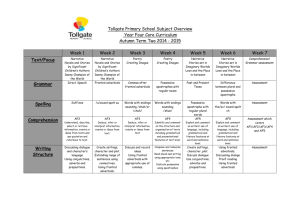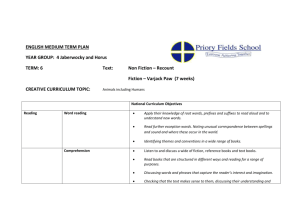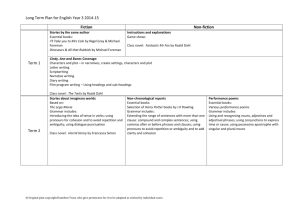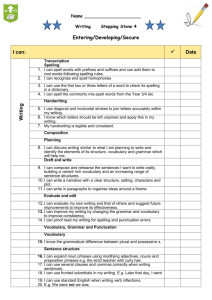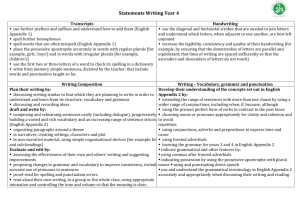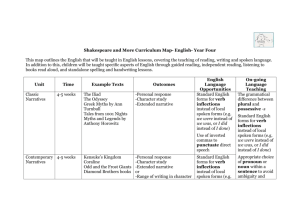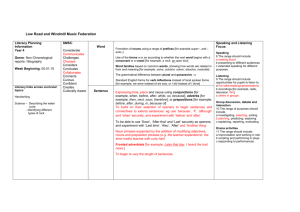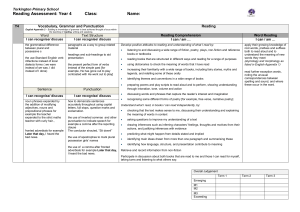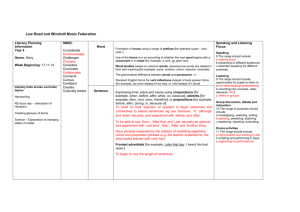Low Road and Windmill Music Federation
advertisement
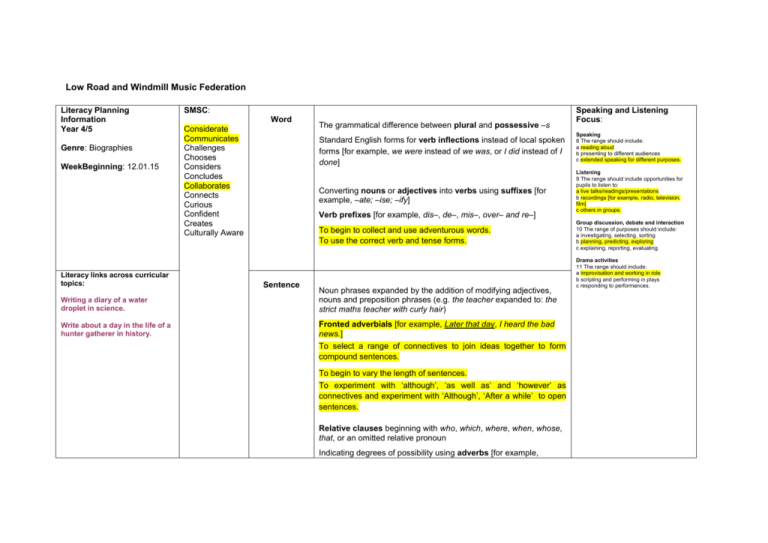
Low Road and Windmill Music Federation Literacy Planning Information Year 4/5 Genre: Biographies WeekBeginning: 12.01.15 Literacy links across curricular topics: Writing a diary of a water droplet in science. Write about a day in the life of a hunter gatherer in history. SMSC: Word Considerate Communicates Challenges Chooses Considers Concludes Collaborates Connects Curious Confident Creates Culturally Aware The grammatical difference between plural and possessive –s Standard English forms for verb inflections instead of local spoken forms [for example, we were instead of we was, or I did instead of I done] Converting nouns or adjectives into verbs using suffixes [for example, –ate; –ise; –ify] Verb prefixes [for example, dis–, de–, mis–, over– and re–] To begin to collect and use adventurous words. To use the correct verb and tense forms. Sentence Noun phrases expanded by the addition of modifying adjectives, nouns and preposition phrases (e.g. the teacher expanded to: the strict maths teacher with curly hair) Fronted adverbials [for example, Later that day, I heard the bad news.] To select a range of connectives to join ideas together to form compound sentences. To begin to vary the length of sentences. To experiment with ‘although’, ‘as well as’ and ‘however’ as connectives and experiment with ‘Although’, ‘After a while’ to open sentences. Relative clauses beginning with who, which, where, when, whose, that, or an omitted relative pronoun Indicating degrees of possibility using adverbs [for example, Speaking and Listening Focus: Speaking 8 The range should include: a reading aloud b presenting to different audiences c extended speaking for different purposes. Listening 9 The range should include opportunities for pupils to listen to: a live talks/readings/presentations b recordings [for example, radio, television, film] c others in groups. Group discussion, debate and interaction 10 The range of purposes should include: a investigating, selecting, sorting b planning, predicting, exploring c explaining, reporting, evaluating. Drama activities 11 The range should include: a improvisation and working in role b scripting and performing in plays c responding to performances. perhaps, surely] or modal verbs [for example, might, should, will, must] To use an extended range of connectives and openers To select the length of sentence to create the necessary effect. Group NC Levels, PP Children and More Able (MA): LA - Yellow - Jensen Chen 2b+, Lili-Mae Ledger 2a , Brooke Sykes 2a (PP), Marika Studzianna 2a+, Preston Finnegan 2b, Savannah Howarth 2a+ (PP) Use of paragraphs to organise ideas around a theme Text To structure writing with clear opening and closing statements Appropriate choice of pronoun or noun within and across sentences to aid cohesion and avoid repetition To begin to identify the features associated with different types of writing and include these in their writing. MA - Green - Ellie Cawthera 3c+, Ellie Thackray 3c, Harley Telford 3b, , Jayda Gray 3c+ (PP), Ben Lake 3b Devices to build cohesion within a paragraph [for example, then, after that, this, firstly] MA- Purple - Aimee-Leigh Dallas 3c (PP), Devon Stott 3b, Lewis France 3b (PP), Javina Kiona 3b (PP) Linking ideas across paragraphs using adverbials of time [for example, later], place [for example, nearby] and number [for example, secondly] or tense choices [for example, he had seen her before] HA - Orange - Elysha Ruddock 3a, Kadee-Leigh Wood 3c+, Rhiannon Davies 3b (PP) Punctuation Use of inverted commas and other punctuation to indicate direct speech [for example, a comma after the reporting clause; end punctuation within inverted commas: The conductor shouted, “Sit down!”] Apostrophes to mark plural possession [for example, the girl’s name, the girls’ names] Us Use of commas after fronted adverbials Brackets, dashes or commas to indicate parenthesis Use of commas to clarify meaning or avoid ambiguity To Use speech marks to denote speech, and begin to use some other speech punctuation. Spelling Focus: Introduction Learning Objective L.O. To write complex sentences To use fronted adverbials. Teaching Remind chd of the features of a biography. Introduce fronted adverbials - describe and show sentences with fronted adverbials in. Talk partners - chd spend 2 mins identifying the fronted adverbial. Go on to show sentences split into parts chd to attempt to put sentences back together on whiteboards. Highlight the use of commas after fronted adverbials. Yellow and Green - turn given sentences written about Steve the Alien from simple sentences in complex ones using fronted adverbials. Improve each sentence by adding in extra information from the clues that they were given. AH and JB Purple and Orange - Chd to write a short biography about Steve the Alien using the clues that they gathered earlier. Chd should make sure that sentences atart with fronted adverbials where possible and they should attempt to write in chronological order. LH Reflection Link to biographies - explain to the chd that sometimes to write a biography we have to piece together bits of evidence. Chd to go to tables and look at the clues that they have about Steve the Alien who has crash landed on our planet. They should write notes on sugar paper. Learning Reflection Session 1: Activation Homework: As a class discuss what we have found out so far - pick out specific dates/ ages and model how to use fronted adverbials such as ‘At the age of 5…’ In the year 2010, …’ 45 mins due to music lessons Go on to show the chd a picture with simple sentence that goes with it. Explain that they are going to attempt to change Chd to write complex sentences. Give the chd examples where fronted adverbials could be used. Yellow - LH to support. Purple - independent. Green - AH to support. HA - JB to work with to discuss ideas and encourage use of higher level connectives. Reflection To write complex sentences Begin by recapping fronted adverbials from yesterday. Using whiteboards chd to match fronted adverbials to the correct ending of a sentence. Reflection Session 2: them into complex sentences by giving more detail about how, when or where the ‘thing’ happened. Display possible connectives that they chd could use to do this. Homework: Spellings to learn for phonics. Give chd 2 mins to talk with a partner and attempt to construct a complex sentence using the given connectives. Share ideas and model writing an interesting sentence. Repeat with other pictures. Session 3: To collect information to write in a biography. To use subject specific vocabulary. Pupils will then work independently to complete the information sheets collecting as much information as they can. They need to write in full sentences and include dates where possible. The sources need to be distributed on their tables so they can refer to them. Watch the Youtube video. Ask pupils to feedback anything they heard on the video that was interesting. If pupils finish they can get an Ipad between 2 and do some more research. Go through the different sources the pupils will have. Read them briefly and ask what sort of things they can learn from them. Homework: Reflection Explain that today they will be gathering information on Blackbeard the pirate. Seeing as they can’t meet him to ask him anything they will have to rely on sources of evidence that tell us things about him. Session 4: To use subject specific vocabulary. To use the correct tense To use complex sentences Re-watch Video to remind them about Blackbeard and discuss who he was/what we found out yesterday. Who, what, where, when, why? Explain that today they will be writing a biography of maybe 4 or 5 paragraphs about Blackbeard. LA - focus on ensuring paragraphs are used in the writing. Make sure correct tense is used throughout the writing. Support from JB MA - as above - AH to ensure chd are using interesting vocab and attempt to use fronted adverbials in their writing. HA - sit with LH - focus on use of fronted adverbials and complex sentences using interesting vocab. Reflection Talk about chronological order. Why is it important (easier to follow) can they order the information? (Green, blue, pink, black, red) Pupils will then work independently to write a biography of Blackbeard. They should work quietly. The sources will be on their tables to help them as will their fact files from yesterday Model writing a good opening paragraph. Take pupils suggestions (maybe 2 per bit) But then give own suggestion. Finally show them and read my finished one. Session 5: To retrieve information from a text REINFORCE features of a bio If needed, initially give chd time to finish biographies started yesterday. To answer SATs style questions Reading comprehension focusing on 2 and 3 mark SATs style questions. Practise answering questions from the text as a class, discussing model answers as we go. Chd then go on to having a go at questions by themselves. Reflection Read a text with the chd, discussing the text as we go. Read aloud a question to the chd about the text - what clue do we have about how much information is needed to answer the question? Explain that the number of marks that can be awarded/space left for answer gives us a big clue about what is expected. Homework: Worksheet on fronted adverbials As a class answer 2/3 mark SATs style questions. Get chd to find information in the text to answer the questions and suggest answers - as class improve answers.
